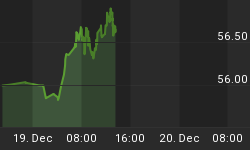The end of an era has arrived. Alan Greenspan stepped down as Chairman of the Federal Reserve. A position he has held since August 1987. In his last FOMC meeting, the Federal Reserve voted to increase rates another 25 basis points to 4.5%. Despite lower than expected growth during the fourth quarter, the Federal Reserve said that "expansion in economic activity appears solid." It did add that, "recent economic data have been uneven." In its hint on what the future may hold it said that, "some further policy firming may be needed..." The two changes were dropping "measured" and changing "likely" to "may." Some are speculating that by leaving the word "some" it opens the possibility to two more rate increases. Traders have responded in this manner. Just two weeks ago, traders were pricing in only an 80% probability of one more rate increase. Now, traders are pricing in about a 50% probability of two rate increases by the June 29 meeting.
Economic data released over the past week indicated that that manufacturing sector continued to expand in December. Durable goods orders increased 1.3% in December, which was stronger than expected. Additionally, November orders were revised from up 4.4% to up 5.4%. Orders excluding transportation increased 0.9% and had a major revision to November orders. Instead of dropping 0.6% in November, durable goods orders excluding transportation jumped 0.6%. Compared to last December, durable good orders increased 13.7%. Transportation orders jumped 31% over the past year on the strength of non-defense aircraft orders (up 174%). Excluding transportation, orders increased 6.2% from last December. The manufacturing ISM survey dropped 1.8 points to 54.8. This was also lower than the 55.5 economists expected. Prices paid increased two points to 65.0. This was the first increased since October.
Residential housing has been uneven over the past few months. Existing and New home sales dropped in November. New home sales picked up 2.9% in December, but it does not appear that existing home sales will rebound. The National Association of Realtors reported that the number of homes pending sale dropped 3% in December from November and is 6% less than a year ago. This is the largest year-over-year drop since the index started in January 2002. With interest rates ticking back up over the past few weeks, home sales could come under further pressure. New home prices have been slowing during the past couple of months. In December new home prices dropped. The average price of a new home dropped 3.4% compared to last December, and the median price dropped 4.0%. This was the first year-over-year decline in average price since November 2001 and the first drop in the median price since December 2003. The number of homes for sale increased as well keeping the months supply at 4.9. The percentage of homes sold for more than $500,000 dropped to 8% in December from 11% the previous three months.
Retail sales have also picked up recently. Wal-Mart's January same store sales were up 4.7%, which was the high end of guidance, 3-5%. This was the largest increased since May 2004. Wal-Mart said that food sales were stronger than general merchandise and average ticket increased more than traffic. The ICSC reported that chain store sales increased 4.0% during the week ending January 28. Merrill Lynch noted that last month was the warmest January in 112 years.
The personal income and spending report from the Department of Commerce showed that consumers increased spending more than incomes advanced in 2005. This was the fifth consecutive year that spending growth outstripped income growth, which has resulted in a negative savings rate. The savings rate for 2005 was -0.5% and was the lowest rate since 1933. This trend has been a boon to retailers. From the 1970s to about 1998, personal consumption accounted for about 65-67% of GDP. During the late 1990s and early 2000s it steadily increased to over 70% and accounted for 70.6% of GDP during the fourth quarter 2005. With consumers now spending more than their income, spending growth will likely slow. One of the sources of increased spending has been from escalating housing prices. Now that housing inflation has moderated, spending growth will match income growth at best. Spending should increase less than income growth over the next few years as consumers realize that it is not financially prudent to live paycheck-to-paycheck.
About 60% of the S&P 500 companies have reported fourth quarter results and 62.7% have beaten analysts' estimates with 20.1% falling short. This is a little worse than last year when 65.8% of S&P 500 companies beat Wall Street earnings estimates. Earnings growth is estimated to be 13.5% for the fourth quarter and 9.8% for the first quarter. On January 1, estimates were for 13.4% growth and 12.6% respectively. Looking at the aggregate S&P 500 earnings are misleading. Because of the unbalanced economy there are several outliers that skew the average. The energy sector is expected to increase earnings by 49%. Excluding the energy sector, earnings growth for the other nine sectors is 9.1%. As a group, consumer discretionary companies have reported that earnings have fallen by 1%, however, General Motors skews the average. Excluding GM's $2 billion loss, consumer discretionary companies would report earnings that were 10% above last years level. GM also brings down the growth rate of the overall S&P 500 by over 100 basis points.
Speaking of General Motors, the largest US automaker announced that its sales rose 7% in January. This was the first increase since the employee pricing promotions last summer. Sales were boosted by a 30% gain in fleet sales, which the company described as an aberration. With this benefit, sales would have declined 7%. Ford also posted an increase in sales, up 2%. It also cited strength in fleet sales. Once again the Japanese automakers posted better results. Honda's sales were up 20% and Toyota's sales increased 14%. The Asian nameplates added over 120 basis points to market share compared to last year.















